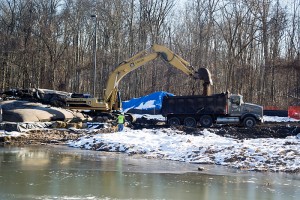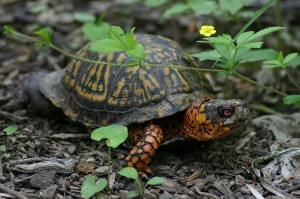

Amid the various construction and renovation projects on campus, the Health Center’s pond on the lower campus is undergoing its own transformation.
The pond is really a man-made detention basin that was “constructed” in the early 1960’s when the Health Center was being built as part of our storm water management plan.
“By design, its purpose is to protect the waterways downstream by providing an onsite place for silt and sediment to settle out of the storm water,” says Paul Hudkins, project manager for campus planning, design and construction at the Health Center.
Over the years the pond has become overgrown, with invasive plant species, leafy material and sediment. “Engineers determined the detention basin was nearing capacity and that it needed to be restored to its original design and capacity,” explains Hudkins.
But according to the Connecticut Department of Energy and Environmental Protection (DEEP), the pond had become its own ecosystem with various species of plant life and wild life ranging from blue herons to red foxes. As a result, design work was delayed until recently.

So for the past two years, UConn has worked diligently with DEEP and the Army Corps of Engineers to carefully design a plan to restore the basin to its original intent.
One of the major requirements for the project was that it had to be completed between September and February. There are two reasons for that – the Eastern Box Turtle and the Jefferson Salamander. Both of them inhabit the pond and the restoration work could not interrupt their breeding seasons.
When the contractor, O&G Industries of Torrington, started work in the fall, they began by using GPS technology to measure the bottom of the pond in 150 different locations to determine how many layers of muck they had to remove.
The contractor then used a dredging machine to basically vacuum up the debris and transport it via large hoses into four giant bags located on the pond’s shore. The bags were made of porous fabric which allowed the water to drain out but left the sludge in the bags.

More than 8,000 cubic yards of debris were removed from the pond, mostly leafy material and sand from winter roadway operations. The debris was taken to the Connecticut Resource Recovery Authority landfill.
During the clean-up process, invasive species like purple loose strife were also removed from the pond.
In the spring, crews will replant grasses and ornamental shrubs to restore the landscape to its natural beauty and allow Health Center employees and visitors to enjoy the pond again – just as they have for the past 50 plus years.
Follow the UConn Health Center on Facebook, Twitter and YouTube.



